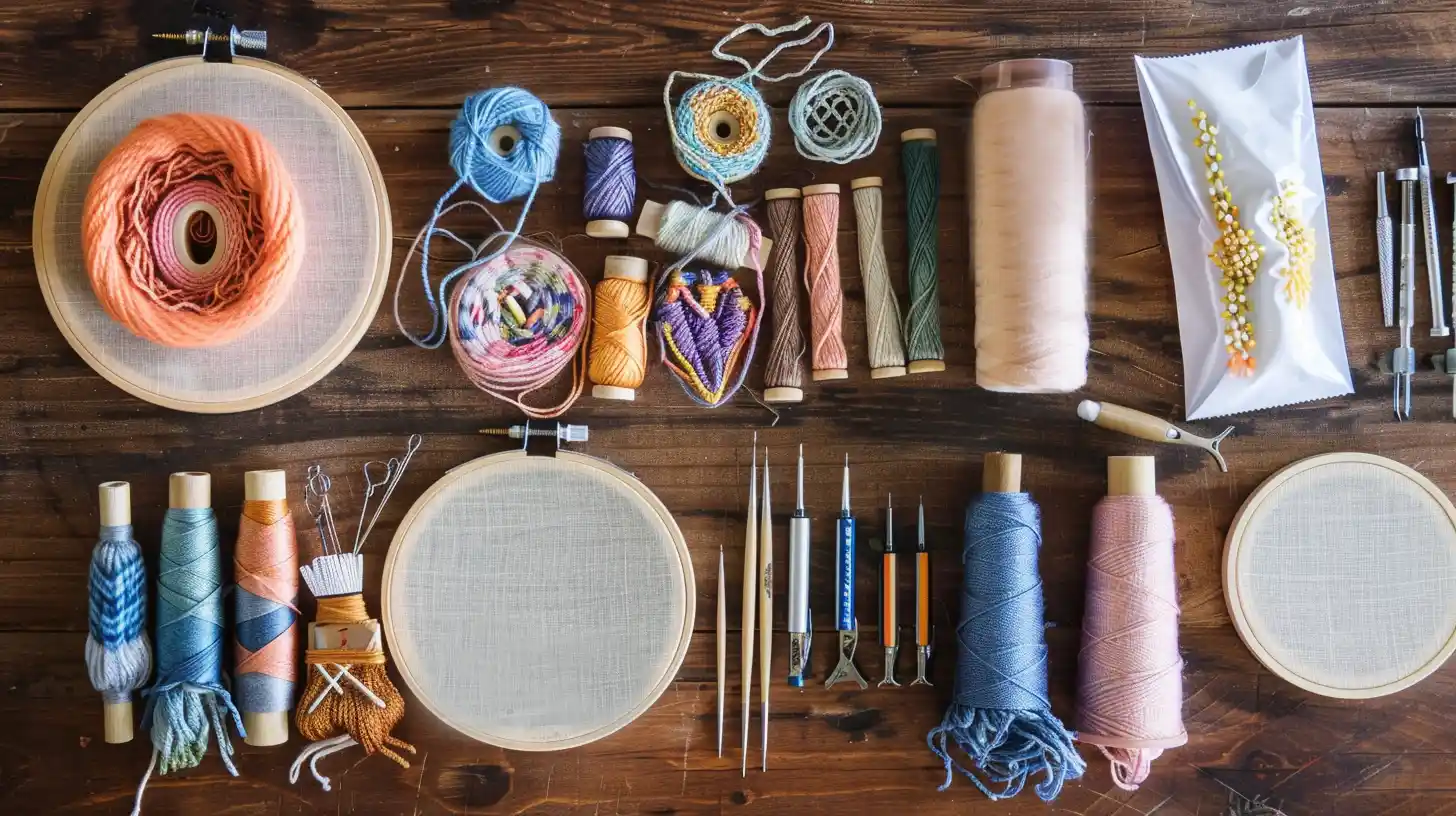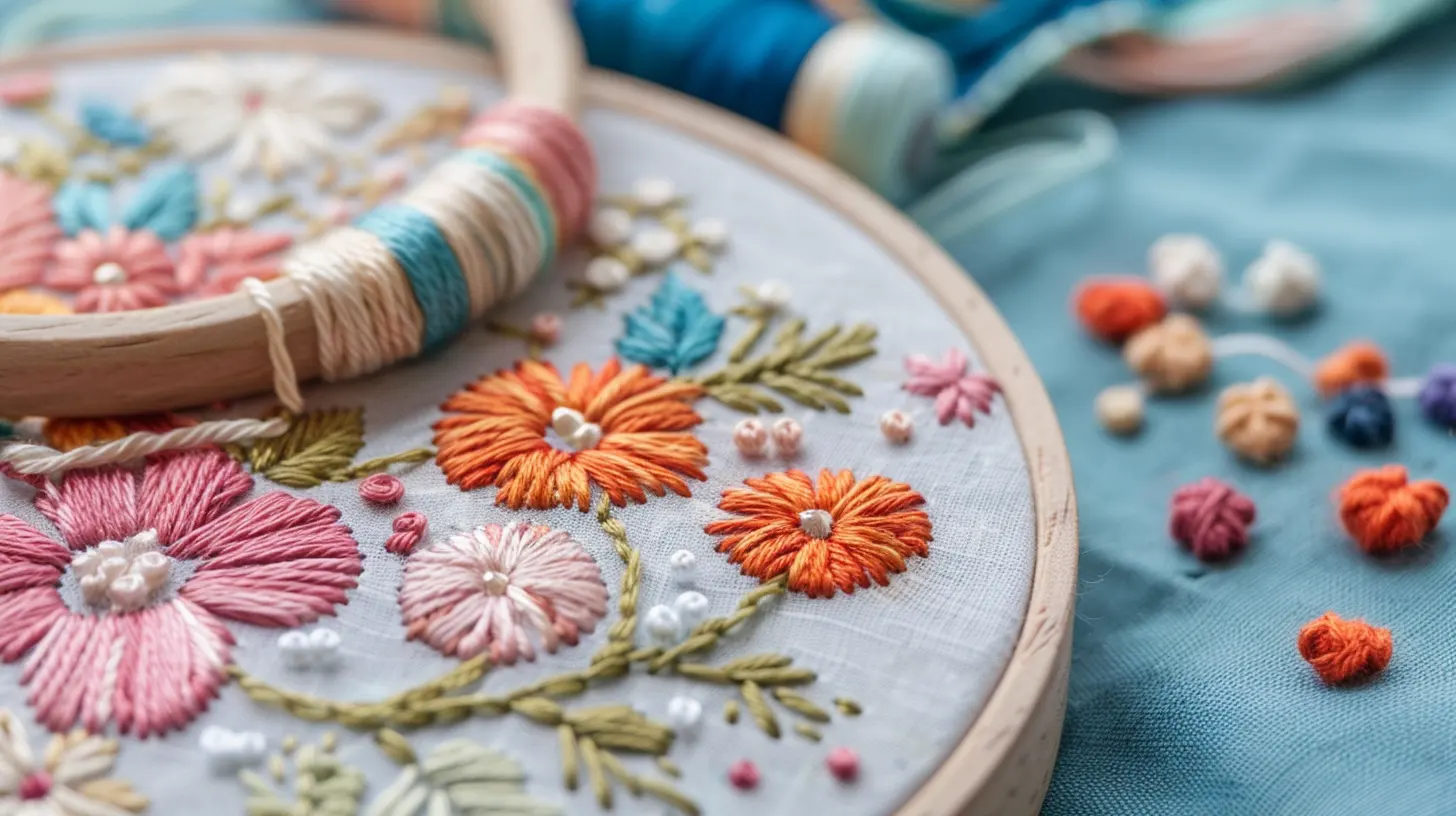Start your embroidery journey with natural fabrics such as cotton or linen. They hold stitches more effectively! Match your needle size to fabric weight for a smoother experience. Opt for high-quality threads. Sharp scissors ensure precise cuts. Stay organized with a system for your threads! Ensure your workspace is functional, well-lit, and inspires creativity. Embrace your mistakes. They’re all part of your journey toward mastering embroidery. With each mistake, you’ll explore new techniques and opportunities for growth. Ready to take your skills to the next level? If you love embroidery, there are plenty more tips waiting for you.
Key Takeaways
- Select natural fabrics like cotton or linen for a stable embroidery base and enhanced designs.
- Use quality threads for smoother stitching and color retention.
- Create a functional, clutter-free embroidery space that inspires creativity and keeps materials accessible.
- Ensure proper lighting using natural light or LED/daylight bulbs to reduce eye strain and enhance design visibility.
- Embrace mistakes as opportunities for growth and skill refinement in the embroidery process.
Embroidery Tips for Beginners: About Embroidery Materials and Tools

When starting with embroidery, it’s important to choose the right materials and tools for beautiful results.
Choose natural fabrics like cotton or linen. Prepare different embroidery needle sizes to match the fabric’s weight.
Invest in good quality threads, scissors, and hoops/frames – they’ll improve your work a lot.
Choose Natural Fabric for Embroidery
When you start with embroidery, use natural fabrics such as cotton, linen, or muslin for their smooth texture and easy stitching. These materials provide a stable base for intricate designs. These fabrics also allow the needle to glide smoothly through the fabric.
The thread will effortlessly stitch into these fabrics. It ensures your embroidery work lasts longer and maintains its quality over time. Choosing natural materials enhances the overall appearance of your embroidery. It makes the stitching process more enjoyable.
Remember to avoid synthetic fabrics as they may not hold stitches well and can challenge your needlework skills. So, for a successful embroidery project, stick to natural fabrics.
Prepare Embroidery Needles in Various Sizes
To achieve neat embroidery, use different needle sizes that match the fabric weight and density. Needle sizes are crucial in determining the type of stitch you’ll produce. Smaller needles are ideal for delicate fabrics like silk. Big needles are better for heavier fabrics like denim.
Do not underestimate the size of the needle eye. It should accommodate your chosen embroidery floss, ensuring smooth threading and hassle-free stitching. Sharp needles are ideal for tightly-woven fabrics to avoid snags or pulls. Always keep an assortment on hand to suit your project needs. Remember, selecting the appropriate needle size contributes significantly to the quality of your embroidery.
Invest in High Quality Threads
Investing in high-quality threads can significantly enhance your work. Premium floss brands are renowned for their color retention and durability. These can ensure your designs maintain their vibrancy over time.
High-quality threads reduce the risk of fraying or breakage during the embroidery process. It also provides smoother stitching for a more professional finish. Additionally, these threads offer a broader spectrum of colors and shades, boosting the visual appeal of your embroidery.
One of the best embroidery tips is to always pick threads specifically designed for embroidery. By investing in premium threads, you’re not only creating beautiful designs but also ensuring their longevity. Remember, the quality you put in is reflected in the final result.
Choose Sharp Embroidery Scissors
Have you ever considered how critical sharp fabric scissors are to your stitching projects?
Quality embroidery scissors with sharp tips are essential for precise cutting of threads and fabrics. They guarantee clean cuts without fraying or damaging your masterpiece. The fine, pointed tips allow you to easily maneuver around intricate stitches and details.
Remember, it’s not just about having sharp scissors, but scissors specifically designed for embroidery. These can ultimately improve the quality of your finished projects.
To maintain the sharpness of your scissors, regular cleaning and proper care are necessary. Don’t underestimate the power of a good pair of scissors. They can make a significant difference in your embroidery work.
Select Suitable Hoops or Frames
When mastering embroidery, it’s important to use the right embroidery hoops or frames for your projects. Wooden hoops are a top choice. It provides superior tension control and enhanced durability. Their good quality ensures less slippage and more stability while you work.
The hoop size is crucial, too. It should be chosen based on the size of your project and the thickness of your fabric. This will guarantee excellent stitching results. Remember, maintaining consistent fabric tension is key, so don’t hesitate to adjust your hoop as needed during the process.
Use the Correct Stabilizers for your Needs
When embroidering, the stabilizer you choose is important for the final result. The fabric type and design complexity are key factors in your selection.
For light to medium weight fabrics, opt for a tear-away stabilizer. It provides ample support and can be easily removed once you’re done with your stitching. If you’re working with stretchy or delicate fabrics, a cut-away stabilizer is your best bet. It will maintain stability and prevent distortion.
It’s essential to match your stabilizer to your fabric and design needs. This not only ensures a smooth embroidery process but also contributes to a more professional and polished result.
Hand Embroidery Tricks: Techniques You Need to Learn

Mastering hand embroidery techniques will take your creativity to new heights.
Finding the right transfer method is crucial for your style and project requirements, whether it’s transfer pens or carbon paper.
It’s important to learn common stitches like the back stitch, French knots, and the satin stitch to add versatility and depth to your designs.
Find the Ideal Transfer Method Based on your Needs
Finding the right way to transfer embroidery patterns onto fabric can greatly improve the quality of your hand embroidery. As a beginner, you might find iron-on transfer patterns convenient. They’re easy to use and effectively imprint designs onto fabric with heat.
Alternatively, consider using a water-soluble stabilizer for transferring intricate designs onto dark fabrics. If you’re working with light-colored fabric, carbon transfer paper or a light box can ensure precision.
For a personalized touch, embroidery pens or pencils are great for freehand drawing designs directly onto fabric. Remember, experimentation is key. Try out different methods to find the one that best suits your project’s complexity and fabric type.
Master Common Embroidery Stitches
Ready to take your embroidery skills to the next level? Let’s dive into mastering common hand embroidery stitches that are essential for any project. There are different stitches.
- Start by perfecting the back stitch, ideal for outlining and adding fine details.
- Next, let’s practice the French knot. It’s perfect for creating textured accents like flower centers or eyes.
- The satin stitch is a must-learn, allowing you to fill in shapes with smooth, glossy threads for a polished look.
- For decorative lines, outlines, or even filling areas, turn to the chain stitch.
- Lastly, embrace the stem stitch for creating flowing lines and outlines with a twisted rope-like appearance.
You can use many stitches in your needlework. Mastering these stitches will undoubtedly elevate your hand embroidery projects.
More Embroidery Tips
You’ll find that keeping an organized embroidery environment greatly enhances your efficiency and overall stitching experience.
Good lighting is essential as well. It not only reduces eye strain but also helps in achieving precise, intricate designs.
And remember, don’t be afraid to make mistakes – they’re stepping stones to mastering your embroidery skills.
Have an Organized Embroidery Environment
It is essential to maintain an organized embroidery environment. Please start with properly labeled containers for all your supplies. Use clear storage boxes for visibility and easy access, especially for your threads, needles, and various tools.
One of the most efficient embroidery tips and tricks is to implement a system for thread organization. Consider color-coded bobbins or thread racks to streamline your stitching process.
Remember, your embroidery space needs to be more than just functional. It should be an area that fuels your creativity. So keep it clutter-free and inspiring by displaying finished projects or inspirational images.
Has Good Lighting
In embroidery, good lighting is essential for accurate stitching. It reduces eye strain, and highlights the details in your work. Proper lighting is crucial for needlework. It enhances the visibility of your embroidery design, ensuring precision in every stitch.
Natural light is best, but if not possible, LED or daylight bulbs are great alternatives to simulate natural lighting. Position your stitching session near a window or consider investing in a task lamp. Shadows on your embroidery fabric can be distracting; avoid them by placing your light source at an angle.
Don’t Be Afraid to Make Mistakes
Ever made a mistake in your embroidery work? Don’t worry, it’s not only perfectly normal, but also a valuable opportunity to hone your skills and creative prowess. Embrace these mistakes as part of the journey.
Even a wrong snip with scissors can be a chance to learn a new technique or style. Embroidering isn’t about perfection; it’s about experimenting, learning, and growing.
So, don’t let the fear of making mistakes hold you back. Even experienced embroiderers can make mistakes. It’s all part of the process. Remember, each mistake is a stepping stone towards mastery.
Conclusion
You’ve journeyed through a world of embroidery tips and tricks. Learning about the right materials, tools, and techniques. Now, armed with this knowledge, you’re prepared to dive deep into the art of embroidery.
Remember, attention to detail, creativity, and care for your equipment will make your projects stand out. So, go ahead and thread that needle, play with colors and textures, and let your creativity shine.
Happy stitching!

